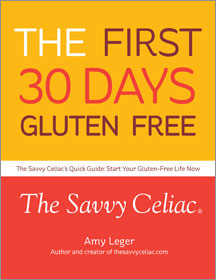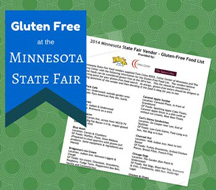Studies Consider Gluten Free Eaters in Arsenic & Rice Investigation
November 3, 2014 by Amy Leger | G+ Amy Leger
“X” Marks specialty gluten free items that have rice in them. If we weren’t GF they probably wouldn’t normally contain rice. (photo from 2012)
I don’t know about you, but we have rice a lot in our household. We have one gluten-free eater– but a lot of rice gets made at dinner as a side dish, but also as an ingredient often for baking for everyone to enjoy.
So I have been highly interested in this arsenic in rice investigation that has been going on for more than two years. Consumer Reports reported on the fact that rice had higher levels of arsenic in it back in fall of 2012.
Then the FDA investigated and reported on it about a year later with similar results. Now two new studies are out looking specifically at the impact of arsenic in rice on gluten free eaters; how much arsenic are we getting and is that bad?
According to one of the studies, “rice tends to accumulate arsenic due to its cultivation under flooded conditions, where anaerobic soil conditions lead to high arsenic availability to the plant”. Inorganic arsenic is the most problematic here. It is considered a group 1 carcinogen according to the International Agency for Research on Cancer known to cause bladder, lung and skin cancer.
Arsenic in Gluten Free Food for Adults
One article published in Food Additives and Contaminants journal and Pub Med in late August, analyzed adults with celiac and their exposure to inorganic arsenic in rice. Arsenic speciation in rice-based food for adults with celiac disease study tested 32 products from categories of baking flour, breadcrumbs, pasta, bread/toast, pastries (biscuits, cereal bars, cupcakes and cakes), beer and rice and soya milks.
Pasta, baking flour and breadcrumbs had the highest amounts of total arsenic and inorganic arsenic. The daily intake of inorganic arsenic by men and women was estimated to be within the Benchmark Methodology Dose Limits (BMDL) and “consequently a risk to this segment of consumers cannot be excluded”, the report said. The report noted some people will consume more or less than the average estimate, plus this food can affect family members of those with celiac who, by default, eat more rice-based products.
The report acknowledges that they don’t really know how the inorganic arsenic affects adults with celiac– because there haven’t been any tests on that as of yet.
Finally, researchers are asking manufacturers to work with companies that create rice with low inorganic arsenic content. “This should be a must for food companies manufacturing this type of products and willing to provide their clients/consumers with the safest products,” researchers said. Companies like Lundberg Farms began arsenic testing a few years ago and put reports on their website.
Arsenic in Gluten Free Food for Children
Researchers published Inorganic and Total Arsenic Contents in Rice-Based Foods for Children with Celiac Disease in the Journal of Food Science in January of 2014. The study looked at rice-based foods for gluten free children. They found if rice was a major ingredient in a product, the higher the arsenic level was. Pasta and breakfast cereals had the highest percentage of total and inorganic arsenic levels. Cereal had the highest radio of inorganic to total arsenic.
Researchers brought up previous studies that brown rice had more inorganic arsenic than white rice. They said, “Without any doubt the use of white rice and flour in the food industry, especially in products aimed for infant and people highly depended on rice, is one of the best solutions to reduce arsenic exposure.”
Concluding the research, investigators pointed out daily average intake by children of these products was with in the BMDL and there was “no serious and immediate risk to the health of children between 2 and 5 years old suffering from celiac disease”.
However, I asked one of the researchers, Angel Carbonell Barrachina, Professor in the Department of Agro-Food Technology at Miguel Hernandez University in Spain, and co-author on these studies, whether a parent of a gluten free child should be overly concerned about all of this information?
“They should be concerned but not worried. I think they must be aware of the ubiquitous presence of arsenic in rice-based foods, and the fact that they should use a mixture of cereals and not only rice products in the diets of their children.” – Professor Angel Carbonell Barrachina, co-author of the studies
He said parents should look to include other gluten free grains in their children’s diets including corn, soy, quinoa, and buckwheat. Making a diet that is equal in different grains, which includes rice, will not put a child at risk, Carbonell Barrachina says.
Reducing arsenic levels
If you (your gluten free child or a family member) eat rice every day, at each meal, Carbonell Barrachina says both of these studies would consider you as being at higher risk of exposure.
One alternative would be to look to put other grains in your diet. “I am not saying we should go to foods without rice, I am saying we need to look for products mixing rice, corn, buckwheat and other cereals,” Carbonell Barrachina says. For those concerned about corn and Genetically Modified Organisms (GMOs), he says you should consider those other grains listed.
Plus, there are some things we can do in the kitchen to reduce the arsenic levels in rice. “During cooking, it is possible to remove a high percentage of the inorganic arsenic present in the rice if you cook it with high volumes of water, and you discard cooking water,” Carbonell Barrachina says.”This is very simple and will help a lot.” He also says we should completely avoid rice bran as it has the highest content of inorganic arsenic.
He would like to see the celiac organizations come together and start looking for inorganic arsenic levels in their rice-containing products, find out which are the safest out there and report that to the community. “This together with the establishment of maximum legal limits for inorganic arsenic will for sure lead to safer foods,” Carbonell Barrachina says. “Celiac consumers should claim the safest possible foods because they are paying high prices for these products.”
This is a hot topic. Dartmouth is also conducting a study that could shed new light on how rice and arsenic could affect people with celiac disease. We will have to wait an see what all this research means as well.
Tags: alternatives, arsenic, celiac, free, gluten, gluten-free, grain, prevent, reduce, research, rice, sensitivity, study, symptoms



November 4th, 2014 at 1:24 pm
These types of studies make me curious on rice products, mostly cause my in-laws are Asian and talking to my boyfriend it is very customary for them to have rice at every meal. I give him a hard time cause even having CD and eating a lot of rice some things are still lost on me, like fried eggs with rice, or a burger with a side of rice. But I’ve asked him what he thinks of the arsenic levels and such and he shrugs it off. His whole family does and I can’t see where it’s much different….
November 8th, 2014 at 1:51 pm
I’ve become somewhat wary of rice. It’s the main ingredient in many commercial GF baked items and mixes. I mainly bake from scratch and use a sorghum mixture (3 parts sorghum flour, 3 parts potato starch, 2 parts tapioca flour). I always have good results with that.